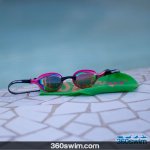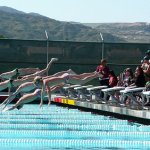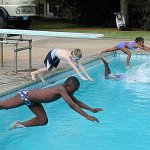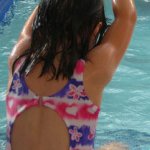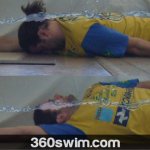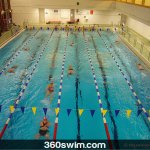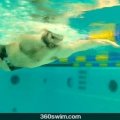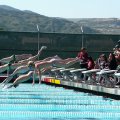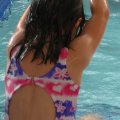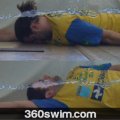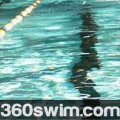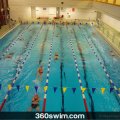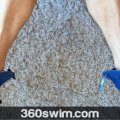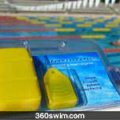STREAMLINE EXPLAINED (HOW DO DRAG FORCES INFLUENCE MY BODY IN SWIMMING?)
"Streamline, streamline, streamline", if I had a dollar for each time I say this word, I'd be a multi-billionaire at this stage, live in a mansion and have my own private 50-meter pool with a retractable roof.
If you visit this swimming blog often, you've seen it over and over again. But what does it actually mean, and why do coaches obsess about it so much?
Let's dive in.
Quick Jump To:
- What Is Streamline in Swimming?
- Understanding Drag Forces in Water
- Types of Drag in Swimming
- How to Reduce Drag and Improve Streamline
- Conclusion: Streamline Equals Speed
- FAQ
What Is Streamline in Swimming?
In simple terms, streamlining means shaping your body to move through the water with as little resistance as possible.
Think of your body as a broomstick versus a small tree. A broomstick slices cleanly through the water; a small tree, with all its branches, creates chaos and turbulence.
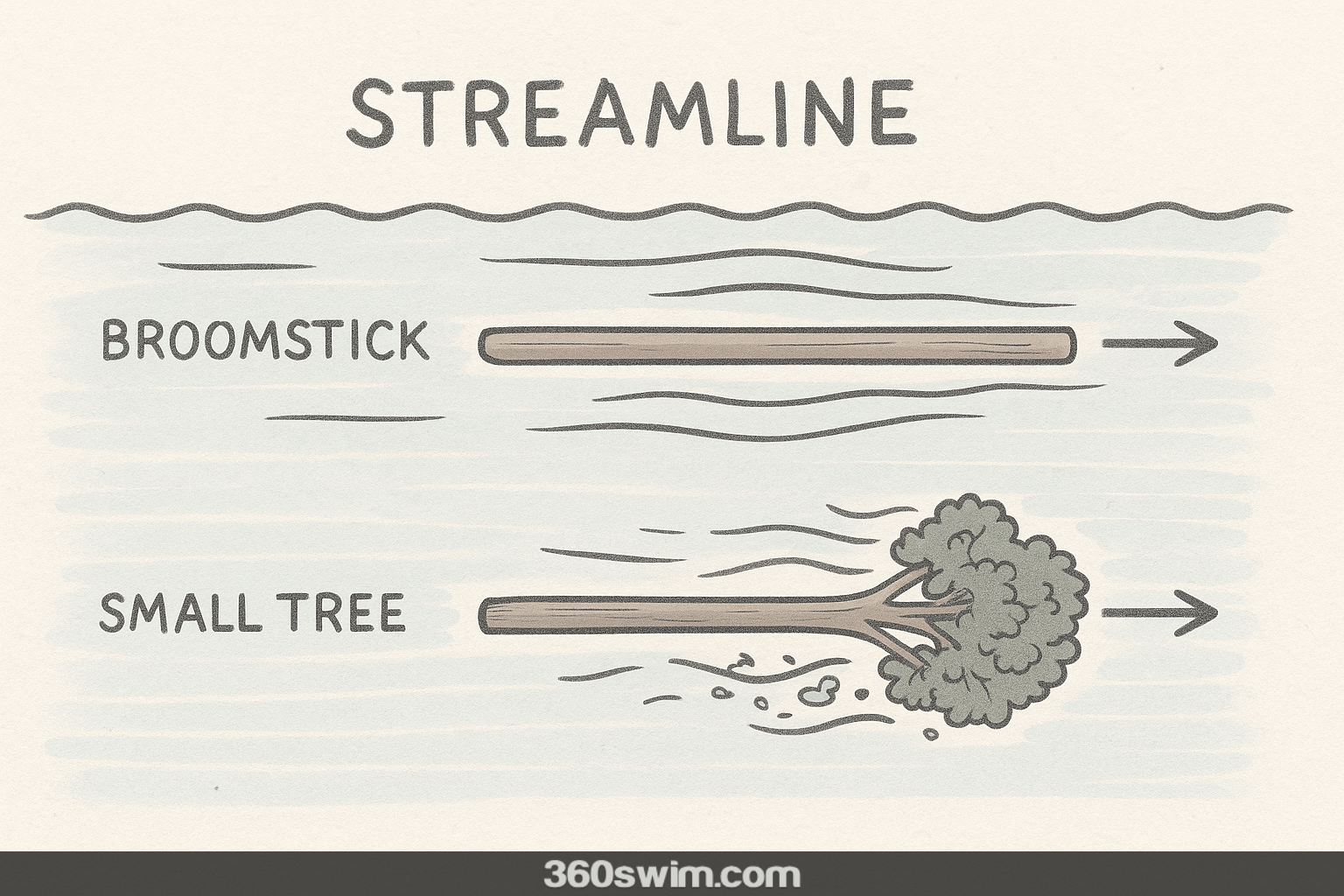
That's the difference between a streamlined swimmer and a floppy one. When you swim, the goal is to be the broomstick, straight, tight, and sleek.
Even if you're not a competitive swimmer, good streamline makes every lap easier, faster, and more enjoyable.
The better you are positioned in the water, the more enjoyment you will have from swimming and the more you can swim and learn.
Understanding Drag Forces in Water
Once you've learned to float and overcome gravity, the next challenge is drag, the invisible resistance that slows you down every time you move through water.
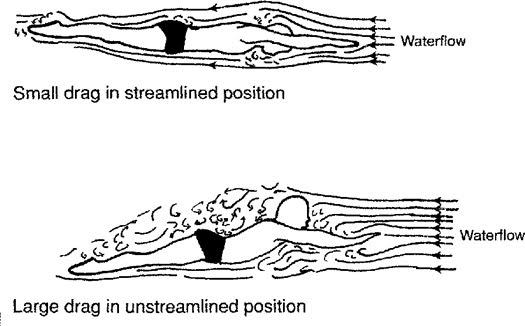
The better you understand drag, the better you can control it.
Swimming scientists identify three main types of drag that affect your body, form drag, frictional drag, and wave drag. Together, they determine how efficiently you move.
Types of Drag in Swimming
Let's break them down quickly:
-
Form drag:
Caused by your body's shape and how much turbulence it creates. Humans aren't shaped like fish, so we naturally create resistance. -
Frictional drag:
Created by water flowing over your skin, suit, and hair. The smoother your surface, the less friction. -
Wave drag:
The big one. As described in the Journal of Biomechanics' paper "Wave Drag on Human Swimmers," wave drag is the energy lost to waves you create at the surface. The faster you swim, the more wave drag builds up.
Wave drag plays the biggest role in slowing you down, and luckily, it's also the one you can most directly influence through better streamline technique.
There are of course other forces that act on our body when we swim, but these are secondary in the streamline discussion.
Ok, now we know what slows us down in the water.
So, how can we decrease these drag forces to become faster and more efficient in our swimming?
How to Reduce Drag and Improve Streamline
Since the wave drag seems to play the biggest role in slowing our swimming down, let's focus on it first.
As described in the many scientific publications, wave drag increases as our swimming speed increases. In other words, as you swim faster, you are also causing more waves to be formed behind and around you.
And as we said above, the more waves you generate around you, the more wave drag.
Here's how to reduce drag and become a smoother, faster swimmer.
1. Push Off the Wall at Lower Depths
Avoid pushing off right at the surface. Research shows that wave drag drops sharply even 0.5-1 meter below the surface.
That's why the underwater dolphin kick, sometimes called the "fifth stroke", is the fastest movement in swimming. It's also why FINA limits underwater swimming to 15 meters per start or turn.
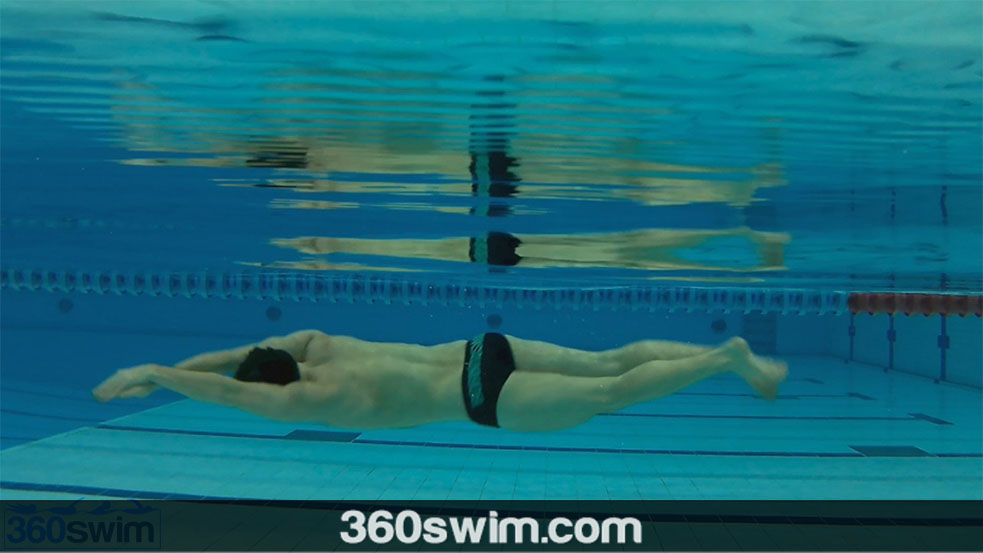
2. Hold a Perfect Streamline Position
When your coach says "hold your streamline," here's what they mean:
- Arms fully extended above your head
- One hand over the other, palms flat, thumbs locked
- Biceps squeezing tightly behind your ears
- Head tucked, chin down
- Shoulders stretched forward, no air pockets around your neck
This position reduces both form drag and frictional drag by keeping your body aligned like a torpedo.
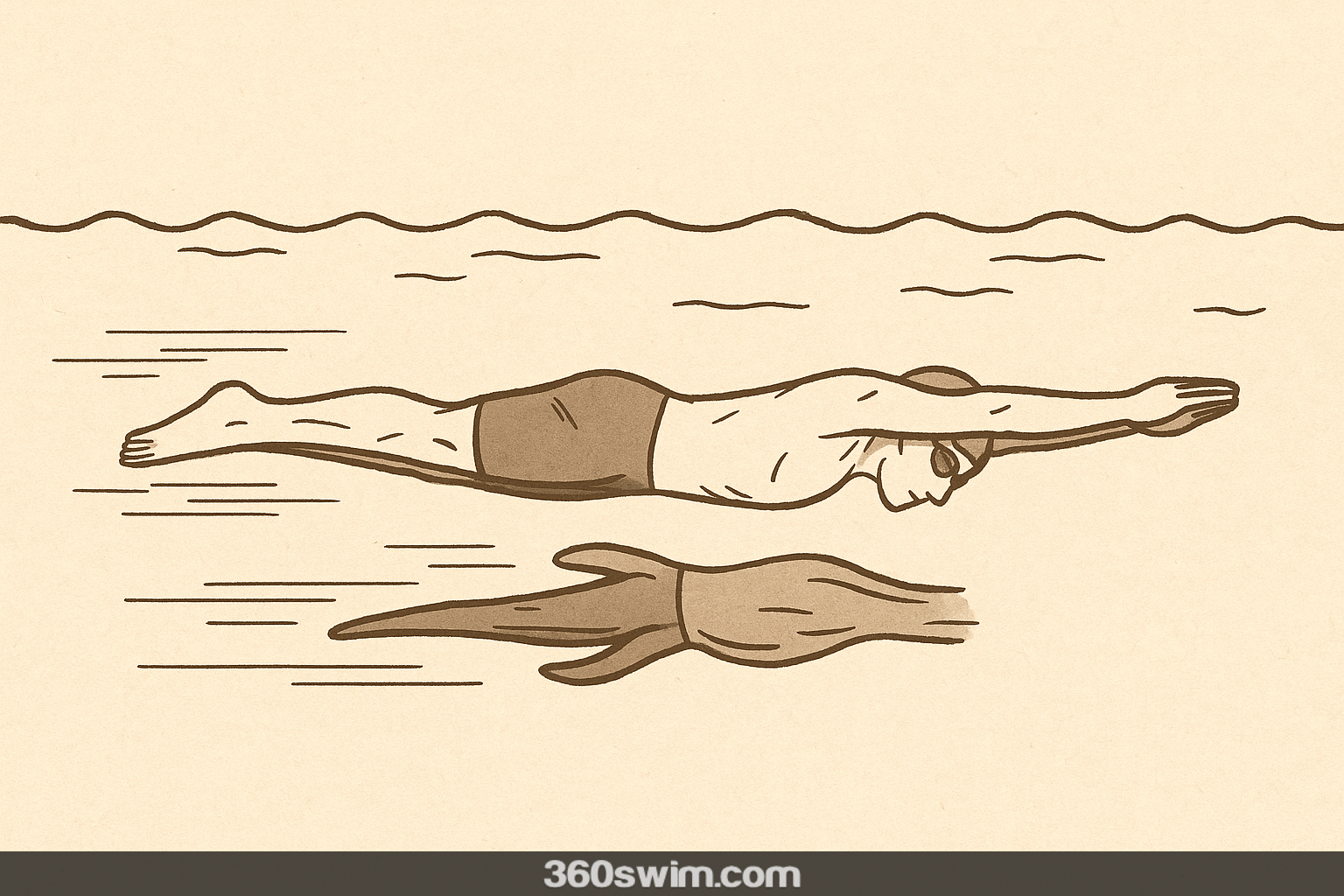
3. Maintain Proper Head Position
Your head should always follow your spine, not fight it.
- In freestyle, look straight down.
- In backstroke, look straight up.
- In butterfly, your head stays low, only skim the surface to breathe.
- In breaststroke, the head moves as an extension of the spine, not independently, unless you want to exaggerate the head slam back into the water for extra power.
Keeping your head aligned reduces turbulence and prevents drag-producing "bumps" in your body line.
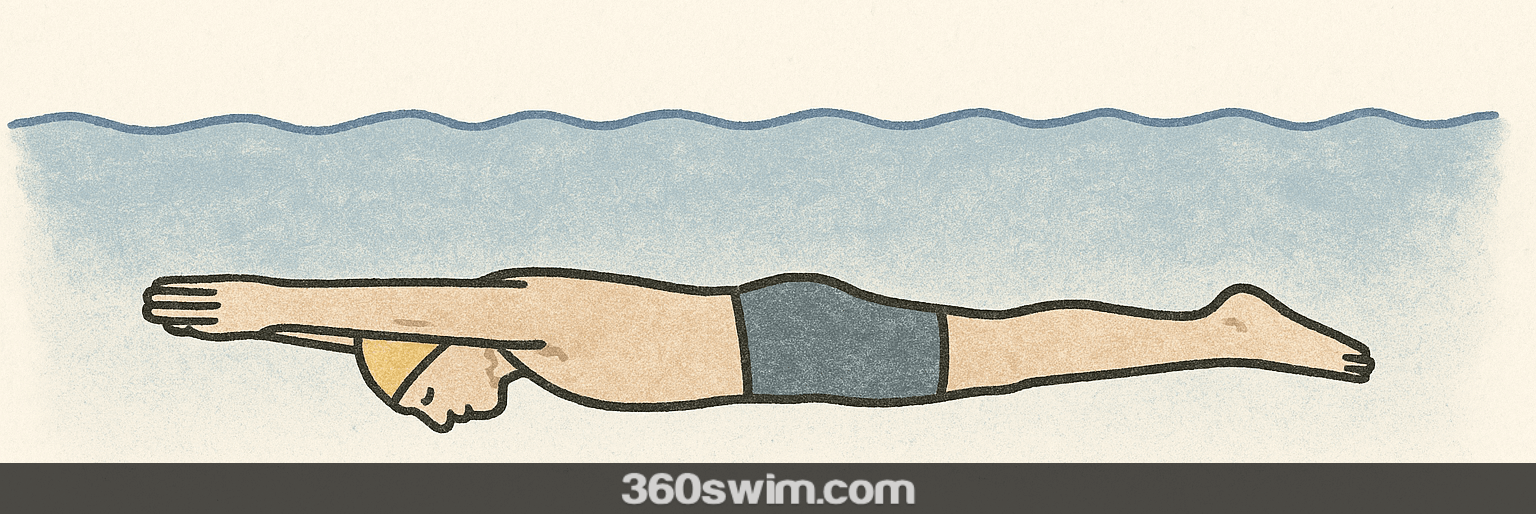
4. Use Body Rotation Effectively
In freestyle and backstroke, rotating your body side-to-side helps extend each stroke and align your body more effectively.
This rotation not only reduces form drag, but also engages your core muscles, giving you more power per stroke with less energy waste.
If you want to go even further and really maximize the drag removal. Here are a few more ways to do that.
5. Wear a Swim Cap
Wearing a swimming cap smooths your head surface, reducing friction drag.
Paired with low-profile goggles, it helps your head cut through the water more cleanly, and keeps your hair from acting like a small parachute.
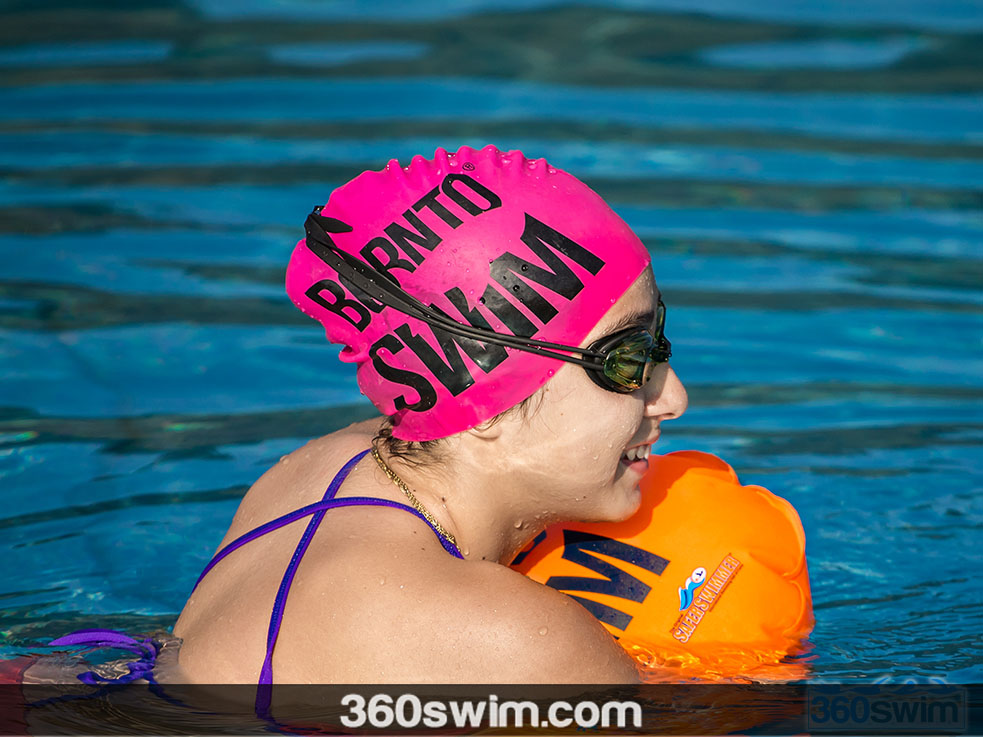
6. Remove Excess Body Hair
Yes, there's a reason competitive swimmers shave before big meets.
Less hair means smoother skin, less friction, and better hydrodynamics.
Shaving also gives a mental boost, that slippery "fresh skin" feel that makes you believe you're gliding faster (and often, you really are).
7. Choose the Right Swimsuit
Not all swimsuits are created equal.
Some high-tech suits reduce drag by compressing your body and minimizing water resistance.
It worked too well, FINA banned full-body suits after they helped shatter dozens of world records in a single season.
For everyday swimmers, a snug, sleek-fitting suit can still make a noticeable difference.
Conclusion: Streamline Equals Speed
So there you have it, the science of swimming faster without swimming harder.
Reduce drag, perfect your streamline, and you'll glide farther with every stroke.
Whether you're chasing a personal best or just want to make swimming feel effortless, remember: the most efficient swimmer isn't the strongest, it's the one who creates the least resistance.
Now go make your inner broomstick proud and learn more about how your specific swimming style can be improved to reduce drag?
Frequently Asked Questions
What does "streamline" mean in swimming?
Streamline means positioning your body to move through water with the least possible resistance (arms extended, head tucked, and body straight). The more aligned you are, the less drag you create.
Why is streamlining important in swimming?
A streamlined body reduces drag and saves energy. It helps you swim faster, glide farther from each push-off, and maintain better efficiency in every stroke.
What are the three main types of drag in swimming?
Form drag (caused by body shape), friction drag (caused by water flowing over the skin), and wave drag (caused by surface waves you generate while swimming). Reducing each one makes you faster.
How can I reduce drag when swimming?
Focus on a tight streamline, push off underwater, keep your head aligned, and avoid unnecessary movements. Wearing a swim cap and smooth-fitting suit also helps reduce surface friction.
Why do competitive swimmers shave their bodies?
Shaving removes body hair that increases friction drag. It also gives swimmers a psychological edge and a smoother feel in the water.
Does swimming deeper really reduce drag?
Yes. Wave drag is strongest near the surface. By pushing off 0.5-1 meter underwater, you eliminate most surface wave resistance and glide farther before surfacing.
What is the best streamline position?
Arms extended above your head, one hand over the other, thumbs locked, head squeezed between your arms, and body stretched straight from fingertips to toes.
Can swimwear really make you faster?
Yes, to a degree. Technical suits compress muscles, smooth body contours, and reduce friction. That's why FINA banned full-body suits in competition, they gave swimmers too much of an advantage.
Does wearing a swim cap make a big difference?
It does. A cap reduces friction drag by smoothing your head surface and preventing hair turbulence, especially at higher speeds.
Is streamline important for recreational swimmers too?
Absolutely. Even casual swimmers benefit from better body alignment, it makes swimming easier, reduces fatigue, and helps you glide more efficiently through the water.
 LNURL1DP68GURN8GHJ7URP0YHRXD3SWDMKJMFWVDHK6TMVDE6HYMRS9A4HSCNCWFXSH3NN0H
LNURL1DP68GURN8GHJ7URP0YHRXD3SWDMKJMFWVDHK6TMVDE6HYMRS9A4HSCNCWFXSH3NN0H
